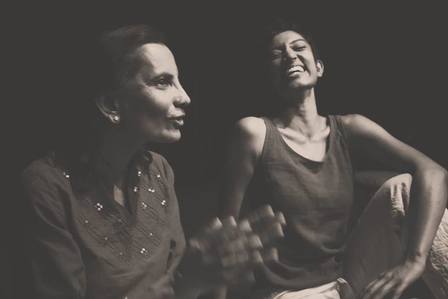|
Please share a little of your story/background and the way your personal story connects to your artistic practice(s)? I am a second-generation Indian American, mostly-native to Arizona. I am a sister and a daughter. My parents moved to this country in the late 80’s, and their journeys, words or advice, and contradictions are some of my greatest sources of inspiration. I am a performance artist, with roots in dance. My training began with the classical Indian dance form, Bharatanatyam, which I still practice and teach. This particular art form is laden with cultural value and community, and without it, I would not be able to conceive of myself as am embodied storyteller. As I have grown older, my relationship to both the stories and myths contained in the movement vocabulary of Bharatanatyam, as well as my parents’ country of origin, has shifted in incredible ways. I have expanded within and outside of Bharatanatyam, to explore contemporary Western movement practices, as well as theatre, poetry, and comedy in my performance work. Greater performative depth has ultimately given me the strength and share my own stories, and challenge narratives handed down to me. What themes or topics do you address in your artistic and cultural work? Since starting to unearth and perform original work, I am most drawn to exploring the same concepts that attract me as an observer: paradox, borders, resilience, identity, and personal relationships. These are a few of the main sources that fuel my work, because in them I find room for myself and others. My work and my story, lives proudly and inherently in worlds of diaspora, bordered identities, and feminism – but amidst these tethers, I explore details of love, life, and curiosities. Humor, improvisation, and storytelling, are the threads with which I try to weave my pieces. Why is artistic expression important to political and social justice movements? Artistic expression, as a vehicle for social and political justice, gives us room to breathe and witness. The rules that govern much of social and political decision-making are intentionally shrouding. Artistic expression, on the other hand, makes explicit its intention to expose; to reveal; to make transparent. Artistic expression inherently does not have to fall within the constraints of politics, because the art gets to challenge and blur the assumptions politics, and even social justice, are built upon. And more simply, artistic expression is the ground for hope of being able to see and acknowledge each other’s shared humanity. All the ways that unity can feel inaccessible and idealized politically and socially, art manages to make possible once again. What is unique to Arizona aesthetics? Do you see a special arts movements happening here, if so, what does that look and feel like? In other words, why should people be paying attention to Arizona artists?
Just within the limits of my own artistic and social experiences in Arizona, I feel a part of an ecosystem of people shaped by their landscapes in sometimes imperceptible ways. The heat unveils a particularly kind of anger, while the expansive skies and powerful Saguaros fill us with a unique patience. The spread out and disconnected urban sprawl of Phoenix makes “stumbling upon” far less likely, and thus makes room for particularly hard, and intentional workers. Cities across Arizona that I am familiar with: Phoenix, Tucson, Douglas, Prescott, Chandler – all of them are attempting to make concrete their own identities, while being in communication with one another. In this sense, I believe Arizona artists and creatives have the potential for sharing resources and collaborating in incredible ways. Ways that cities with more engrained, and demanding identities and expectations have lost sight of. As if that isn’t rich enough, we live in one of the most politically and socially contentious states in the US: our border politics, insufficiently funded educational systems, and political climate at large are constant sources of inspiration; raw material, and offerings for engagement. What is on the horizon for you, and what would you most like to learn this next cycle in your practice? In March of 2016, myself and two of my greatest friends and collaborators – Allyson Yoder and Carly Bates – created intersectional, feminist, personal solo performances and presented them alongside each other. I am thrilled to be in conversation about restaging this work in the fall. I am also continuing to collaborate with ASU’s Performance in the Borderlands initiative and Grey Box Collective. As I continue to work with multiple creative containers, I am always curious about how to best challenge making visible my intentions, voice, and questions as a performer, while best respecting and honoring the intention of each container. In other words, how to best engage with questions that are inherently political, while challenging myself aesthetically, so as to best utilize art/performance as the medium for exploration.
1 Comment
7/24/2023 10:20:02 pm
Appreeciate this blog post
Reply
Leave a Reply. |
Banner photo by:
Carlos Antonio
|




 RSS Feed
RSS Feed